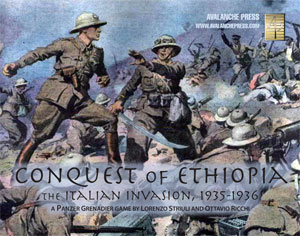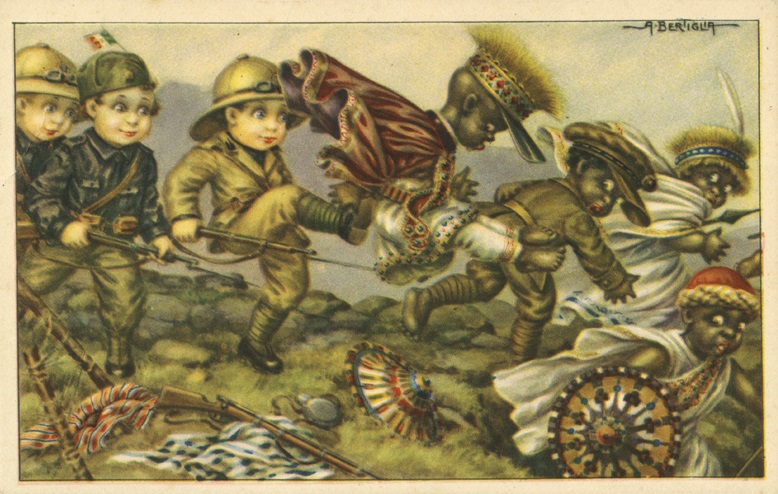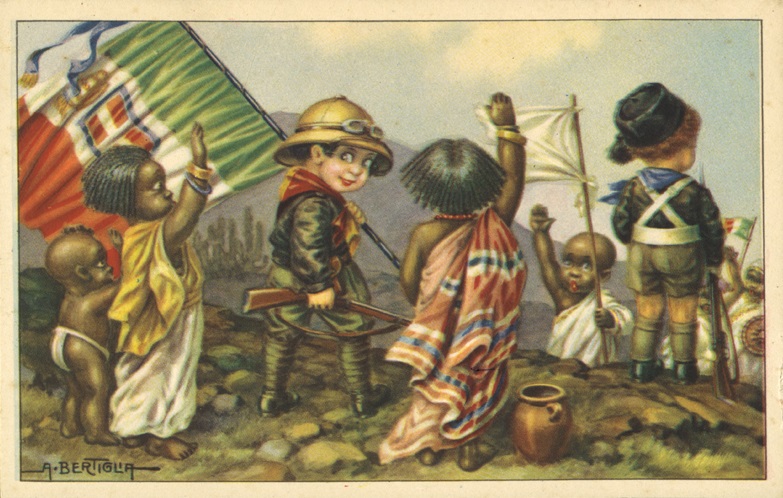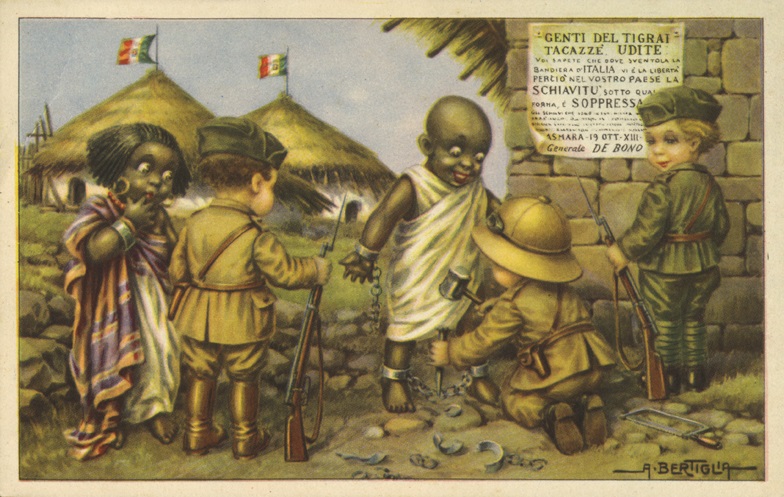| Chemical Weapons in Ethiopia,
Part Three
By Lorenzo Striuli
June 2020
You can read Part One here and Part Two here.
 The safest chemical devices for handling were the arsine artillery rounds, which arrived at the front already filled in Italy and did not require any additional “field” preparation. However, this advantage could not be properly exploited due to some failures of payload dispersion. “State of the art” (for the time!) chemical artillery rounds usually work in two manners: they disperse their payload either by opening the case at a certain altitude, like the afore-described aerial bombs, or by spraying it over the surrounding area once they hit the ground. The safest chemical devices for handling were the arsine artillery rounds, which arrived at the front already filled in Italy and did not require any additional “field” preparation. However, this advantage could not be properly exploited due to some failures of payload dispersion. “State of the art” (for the time!) chemical artillery rounds usually work in two manners: they disperse their payload either by opening the case at a certain altitude, like the afore-described aerial bombs, or by spraying it over the surrounding area once they hit the ground.
Most Italian artillery rounds of the time did not comply with any of these principles. The projectiles used for the 105/28 guns, indeed, were amazingly designed for minimal blast effects when dispersing the volatile and scarcely lethal arsine. Considering also that the payload for each round was very negligible (0.4 kg), a single round would have likely achieved lethal effects no more than one percent of the time. So, the artillery played a negligible role in chemical warfare during Ethiopian campaign. It was employed only during the Amba Aradam battle. In that occasion two 105/28 groups fired 1,367 arsine-filled rounds against the amba (hill) on the 11th, 12th and 15th of February. This implies 546.8 kg of chemical agents (other quantities are reported by several historians but they are simply wrong), a too small a quantity to achieve the required density for effects of any kind (not only the lethal ones, but also the irritating ones).

Kicking ass and taking names.
Since no operational advantage was achieved by this barrage, Badoglio defined this episode (and also the overall use of chemical weapons during the war) as a failure. Near the end of his life the old Marshal recalled again this episode. He told his biographer Countess Vanna Vailati that the aim of such action (actually he confused it with the Tembien battle in his narration) was to hunt out enemies hiding inside some caves. Again, he remembered it as useless, however without detailing the reasons. Certainly, Abyssinians benefitted from the volatile characteristics of the agent in relation to the scarce concentration of the bombardment. Badoglio also added that no other chemical agents were used by the artillery, since an experiment with yprite rounds carried out under his orders in an unpopulated area had shown unpromising results.
Aerial bombing then represented the main method for delivering chemical agents, as around 20 % of the total number of air raids involved chemical bombs. Again, refer to the table for seeing how scarce concentrations of such devices were delivered to targets like fords, camps, caravan roads, mountain gaps, livestock, woods and bush suspected to act as sanctuary for dispersed bands of armed men. This is why we began by describing such use of chemical agents as area-denial weapons, with the complementary role of disrupting the poor Ethiopian logistics, and in this manner some success was reportedly achieved. For example, the great military strategist Major General J. F. C. Fuller, embedded to the Italian army as a war correspondent for the Daily Mail, described the use of yprite to protect the flanks of columns by denying ridge lines and other key areas to the Abyssinians: “in place of the laborious process of picketing the heights, the heights sprayed with gas were rendered unoccupiable by the enemy, save at the gravest risk. It was an exceedingly cunning use of this chemical.”
Partial exceptions to such ways of resorting to chemical agents were the air raid against the Ghorranei and Dagabur garrisons (in the table, bombings on Ghorranei are included in the Dagabur entry), bombed with chemicals several days before Italian assaults. Effects were negligible, as demonstrated by the fierce fighting that, all the same, the Italians had to face. A mix of gas and explosive devices, however, was largely employed during the last phases of the war, on the Ogaden Front. Entrenched camps in Sassabaneh, Bullaleh, Ganu Gadu and Dagabur were repeatedly attacked with yprite, phosgene, fragmentation and high explosive bombs, and some of these strongholds fell without a fight.

Hail the conquering heroes.
Thus, the most important results achieved by chemical bombings were related, perhaps, to: a) preventiingf enemy maneuvers designed to carry out local counter-attacks; b) the disruption of defensive strongholds. Such results, however, rarely determined anything more than psychological effects, and those, likely, were not even lasting, as testified, sometimes by competent foreign witnesses deployed in the theatre of operations. U.S. Army Major Norman Fiske, for example, attached to the Italian troops as an observer, reported that, “the use of chemical agents in the war was nothing more than an experiment. From my own observations and from talking with Italian junior officers and soldiers I have concluded that gas was not used extensively in the African campaign and that its use had little if any effect on the outcome.”
The research carried out by historian Anthony Mockler after the war also ruled out any big impact of chemical weapons on the campaign. Other observers described that the “most effect was on animals; the majority of the Ethiopian armies consisted of a number of individual soldiers, each with his donkey or mule on which he carried rations. These donkeys and mules ate the grass and it killed them, and it was that which really broke down morale more than anything.” A paper from the U.S. Army Chemical Warfare School based on field reports of the time concluded that “the use of gas in Ethiopia did not disclose any new chemical warfare tactics.”
About the casualties, an impressive amount of non-Italian literature reports that the Ethiopians suffered around 15,000 casualties, a figure possibly originating in a Soviet study from the Sixties. Such claims are simply ridiculous. Actually the Ethiopian casualties resulting from Italian chemical attacks are unknown: the Ethiopian estimates, provided several times during the war and afterwards, are unreliable and certainly inflated. Interviews granted by the Negus and Ras to Italian journalists during the Sixties usually described air raids not matching official records about the date or sites, methods of attacks that were not employed by the Italians (like the already-mentioned case of supposed crop dusters), effects of the attacks not matching with the reality of chemical warfare (for example, effects of yprite were described as immediate, while actually its notorious signs on skins, eyes, etc. appear after several hours).
For their part, international aid workers of the time simply failed to prove to the League of Nations any number of casualties. Most of their testimonies referred to several hundred people treated for burns and blisters (among them, sadly, also women and children, possibly relatives of the combatants they followed during military operations according to Ethiopian custom) but reported no reliable direct observation or counts of fatalities, except in one case where the death of twenty peasants was denounced. International volunteers, at any rate, were among the first to denounce such method of war carried out by the Italians, providing also a few photographs that covered only (horribly) injured people.

Breaking the chains.
Italian official records, for their part, never reported estimates of enemy casualties, and it can be deduced that troops advancing toward chemically-bombed areas did not find remarkable amounts of gassed corpses. It is unlikely, for obvious reasons that they would have been dragged away by their fellows if they were contaminated, or even been eaten by animals. It is also unlikely that reasons of secrecy had prevented reports of such findings, since the military high command would certainly want to know the effects achieved by chemical bombings. Nowadays all the documents related to the Ethiopian campaign are completely unclassified, even those related to usage of chemical weapons. Italy is part of the Chemical Weapons Convention regime, which obliges its members to disclose every document pertaining to former chemical arsenals and their usage, effects, etc.
A lessons-learned report written at the end of the war (dated June 1st 1936) by Lt. Col. Venditti of the Chemical Branch failed to detail casualties; however, it confirmed the pre-war thinking that physical conditions in the East African theater of operations would make it difficult to deliver sufficient concentrations of chemical agents on enemy targets. “Agents should have been employed with more density in respect to what is planned for European theaters of war, and, concerning blister agents, harmful effects could be predictably limited to direct contact with the liquid, while vapors [effects] must be considered as negligible (or almost so) unless particular terrain conformations are present.”
Besides the official documents, Franco Bandini was one of the few that reported testimonies related to the discovery of enemy casualties as a result of chemical bombings. At the end of the Second Tembien Battle, indeed, a group of Eritrean troops found approximately twenty enemy regular soldiers lying near one of the Tacazzè river fords. They reported the discovery to their officers in an excited state because were not able to understand how the soldiers had died, since the corpses did not show gun or blade injuries. It is clearly possible to relate this episode to the quantities of chemical bombings occurred in that area during the Second Tembien Battle (among the largest of the whole campaign), as shown in the table. A couple of rare direct testimonies of chemical bombings appeared in newspapers during the mid-Nineties. One is related to the arsine artillery bombardment near Amba Aradm and the other to yprite traces met by troops after the Mai Ceu battle. However, the testimonies do not mention any casualties.
Overall, we can argue that the Ethiopians suffered few casualties from Italian chemical attacks, and this explains why very few Italian veterans of that war ever mentioned them in their memoirs, or depicted them in pictures taken with their personal cameras. After all, concerning the last point, it is worthwhile to remember that private cameras were not so rare among Italian troops and today it is possible to find pictures of the most scandalous subjects of that epoch (prostitutes, local population sick of leprosy, dead bodies, etc.) in family archives of veterans. Sometimes books reporting such private pictures are published in today’s Italy, and in very few cases photographic evidence of gassed enemy casualties are shown. One might argue that tight security measures would have been implemented by commanders in the event of such a discovery, but no orders of this kind have ever been documented; also at the time it was possible to surreptitiously take some evidence of the most outrageous subjects. Sometimes, for example, pictures of guerrilla fighters’ hangings have been discovered in such a manner.
The only successes were related to area-denial and/or harassment effects, and to their subsequent psychological spillover. In this sense, it is worthwhile to recall another observer of the time that dealt with the matter, but from the Ethiopian side. The U.S. Army had attached Captain John Meade to the Abyssinian army. He stated that “mustard gas was the most effective. It caused few deaths that I observed, but it temporarily incapacitated very large numbers and so frightened the rest that the Ethiopian resistance broke completely.” It seems that such psychological effects did not even last for so long, as testified by a Ras Immirù’s son, Mikael Immirù, who described, during a 1980’s interview on Italian television, how the Ethiopians soon discovered methods for avoiding contaminated terrain and not being hit by the chemicals.
In conclusion, the Italian resort to chemical weapons undoubtedly provided very limited operational advantages; furthermore it also constituted a wrongful act from a legal point of view. Above all, it represents a political and historical “own goal,” considering the sinister legacy Italy still carries on the matter, domestically and internationally. Fernando Martini, Colonial Minister from 1914 to 1916, once said that, “colonial wars are won without glory or lost with shame.” Franco Bandini added that Italy managed to pose as a winner with shame, thanks to the gas-related issues, and we can add with stupidity, since there were no real military reasons to resort to any kind of chemical warfare.
Comprehensive Table of Italian chemical bombings during the Ethiopian campaign.
Among the available official documents there are some data discrepancies. Further, there is no unique historical document summarizing the chemical activities of the campaign. So, historians and scholars have drawn up tables on their own by collecting data from historic diaries of Air Force groups and squadrons. Sometimes relevant differences (related to major or minor numbers of actions, or to their dates and locations as well) have come up, so some works may report data in some instances quite different from the following. We have chosen the table included in Gentilli’s work because it includes the most detailed data about the devices dropped and the squadrons involved in each action.
Northern Front |
Date |
Target |
C.500.T. yprite bomb |
22.12.35 |
Dembeguidà – Addi Rassà |
6 |
23.12.35 |
Fords on Buffa and Gollimà river |
8 |
23.12.35 |
Dembeguidà – Mai Timchet |
28 |
26.12.35 |
Meyda Merra |
12 |
27.12.35 |
Meyda Merra and Val Mescic |
12 |
27.12.35 |
Caravan route near Antalò |
8 |
2.1.36 |
Socotà |
28 |
3.1.36 |
Mescalò |
8 |
3.1.36 |
Mai Timchet |
22 |
4.1.36 |
Ascianghi Lake – Agumbertà Gap |
12 |
4.1.36 |
Af Gagà Gap |
4 |
6.1.36 |
Abbi Addi and fords on Segalò river |
18 |
7.1.36 |
Rassi and Jelacà fords |
25 |
12.1.36 |
Fords on Mai Timchet river |
12 |
12.1.36 |
Alage Gap |
8 |
14.1.36 |
Dembeguinà |
12 |
15.1.36 |
Glavà river |
6 |
16.1.36 |
Gaela and Buia |
10 |
18.1.36 |
Scattered targets (maybe opportunity targets?) near Dembeguinà |
22 |
19.1.36 |
Fords on Ati Aitecheb river |
6 |
21.1.36 |
Mai Mescic and fords on Ghevà |
18 |
22.1.36 |
Mai Mescic Valley |
7 |
23.1.36 |
Fords on Ghevà |
24 |
23.1.36 |
Jelacà fords |
6 |
24.1.36 |
Gaela, Edai, Adi Tigrà, Merra |
20 |
24.1.36 |
Addi Rassi |
6 |
25.1.36 |
Several fords |
10 |
26.1.36 |
Fords on Ghevà river |
24 |
26.1.36 |
Fords on Mai Timchet river |
14 |
27.1.36 |
Caravan routs near Fenaroa |
8 |
29.1.36 |
Fords on Tacazzè |
16 |
30.1.36 |
Amba Aradam |
24 |
2.2.36 |
Right flank of the II° Corps |
28 |
2.2.36 |
“” |
18 |
5.2.36 |
Devag ford |
10 |
6.2.36 |
“” |
8 |
7.2.36 |
“” |
8 |
9.2.36 |
Mai Mescic Valley |
20 |
10.2.36 |
Mai Mescic Gap |
32 |
10.2.36 |
Caravan routes near Jelacà |
8 |
11.2.36 |
Ford on Tsellari river |
16 |
13.2.36 |
Several caravan routes |
14 |
14.2.36 |
Jelacà |
8 |
14.2.36 |
Togorà |
10 |
16.2.36 |
Addi Tigrè, Samrè, Amba, Sasseua, Asciuram, Agumbertà, etc. |
42 |
17.2.36 |
Atzalà and Fenaroa |
20 |
18.2.36 |
Caravan routes near Ascianghi lake, Mai Ceu, Quoram |
22 |
21.2.36 |
Fords on Mai Timchet |
12 |
22.2.36 |
Several fords |
21 |
23.2.36 |
Fords on Tacazzè and Ghevac – Atzalà Valley |
44 |
24.2.36 |
Caravan routes near Dubba |
12 |
26.2.36 |
Caravan routes near Ascianghi Lake |
20 |
26.2.36 |
Fords on Jalacà and Ataba rivers |
18 |
27.2.36 |
Several areas near Ascianghi Lake |
24 |
28.2.36 |
Conjunction of Ghevà-Tacazzè rivers |
8 |
16.3.36 |
Quoram |
9 |
17.3.36 |
Bivouacs at Ciolle Amadir |
12 |
18.3.36 |
Quoram |
12 |
19.3.36 |
Quoram – Adi Hailò |
12 |
20.3.36 |
Quoram and Ciolle Amadir |
10 |
21.3.36 |
East of Quoram |
12 |
22.3.36 |
Quoram and Ciolle Amadir |
12 |
27.3.36 |
Agumbertà Gap |
12 |
28.3.36 |
“” |
12 |
29.3.36 |
“” |
22 |
Not reported |
Not reported |
28 |
Somali Front |
Date |
Target |
C.500.T. yprite bomb |
21 kg yprite bomb |
31 kg phosgene bomb |
41 kg phosgene bomb |
24.12.35 |
Areri |
|
17 |
|
1 |
25.12.35 |
Rengi |
|
18 |
|
|
28.12.35 |
Gogoru |
|
36 |
|
|
30.12.35 |
Dagabur, Sassabaneh |
|
48 |
|
|
30.12.35 |
Malca Dida |
|
12 |
|
|
31.12.35 |
Sassabaneh |
|
11 |
|
|
12.1.36 |
Gogoru |
6 |
|
|
18 |
20.1.36 |
Neghelli |
3 |
|
|
|
25.1.36 |
Uadarà |
|
20 |
|
|
16.2.36 |
Hellot, Elamedò |
|
|
|
26 |
17.2.36 |
Magalò |
2 |
|
|
|
20.2.36 |
Hellot, Malca Busa |
|
|
|
24 |
21.2.36 |
Elamedò, Malca Busa |
|
|
|
42 |
23.2.36 |
Ghigner |
1 |
|
|
|
25.2.36 |
Uebi Gestro |
3 |
|
|
|
2.3.36 |
Maleico |
|
7 |
|
|
5.3.36 |
Hellot, Foca |
3 |
|
|
8 |
5.3.36 |
Ducan |
|
|
6 |
|
6.3.36 |
Hellot, Foca |
2 |
|
|
5 |
7.3.36 |
Gunugadu |
6 |
|
|
|
8.3.36 |
“” |
|
|
|
18 |
8.3.36 |
“” |
|
3 |
|
15 |
9.3.36 |
Labbe Darre’s wells |
|
|
|
18 |
11.3.36 |
“” |
16 |
|
|
|
14.3.36 |
Uaresa |
3 |
|
|
|
16.3.36 |
Ganale Doria Falls |
1 |
|
|
|
19.3.36 |
Allata |
2 |
|
|
|
25.3.36 |
Birgut |
6 |
|
|
|
29.3.36 |
Hero |
2 |
|
|
|
30.3.36 |
Bullaleh |
3 |
|
|
|
30.3.36 |
“” |
2 |
|
|
|
8.4.36 |
Sassabaneh |
7 |
|
|
|
8.4.36 |
Dagabur |
6 |
|
|
|
10.4.36 |
Sassabaneh |
5 |
|
|
|
20.4.36 |
Hamanlei |
6 |
|
|
|
20.4.36 |
“” |
|
|
|
36 |
20.4.36 |
Gunugadu, Bullaleh |
6 |
|
|
|
20.4.36 |
Sassabaneh, Bullaleh |
|
|
|
90 |
Click here to order Conquest of Ethiopia!
Sign up for our newsletter right here. Your info will never be sold or transferred; we'll just use it to update you on new games and new offers.
|
